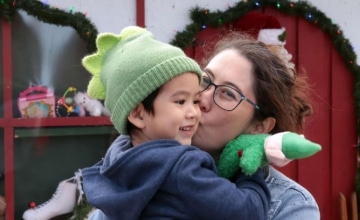Learn more about the magic and value of pretend play.
Pretend play is a magical step forward in a child’s development. They now can imagine and “become” a superhero, puppy, or daddy. Pretend play is also a valuable way to build skills like problem-solving, empathy, and self-regulation. This kind of play helps kids use language in new ways, and children use pretend play to work through new or scary situations, like starting school or going to the doctor. Here’s what you might see your child doing at each age and how you can play along.
The youngest member of our family, two-year-old Haley, likes to pretend. We start by laying her baby doll on the bed, patting the doll gently and tucking a blanket under her chin. “Night-night,” we whisper. Haley raises a finger to her lips and says “Shhh.” Then, a few seconds later, we yell “Wake up!” and dissolve into giggles. This game is repeated many times, and it’s funny every time.
Age 18-24 months
What Your Child Can Do Act out everyday actions, like sweeping the floor, stirring a pot, saying “choo choo” while pushing a toy train, or talking on a toy phone.
Toys to Try Kid-sized versions of objects in the real world, like a toy phone, plastic food and dishes, toy vehicles, and a doll or stuffed animal.
Tips
- Follow your child’s lead. This is your toddler’s chance to be in charge!
- Use play as a chance to practice new language and encourage back-and-forth conversations. In the kitchen: Mmm… this soup is delicious. May I have more? On the phone: Hello, is this Haley? What have you been doing today?
Age 24-36 months
What Your Child Can Do
Use one object to represent something else. A block can be a phone, a car, or a hamburger. (This “symbolic thinking” is an important skill leading up to reading and math, as children learn that just like the block can be a symbol for a phone, letters and numbers are symbols for sounds and quantities.)
Toys to Try
Toys that can be used in a variety of ways, like clothes for dress-up, blocks, and cardboard boxes.
Tips
- Help your child expand her play with questions like What will happen next? or What if…? Who should I be?
- Allow time for unstructured pretend play and don’t clean up too quickly. Children may want to return to their pretend castles and grocery stores day after day.






